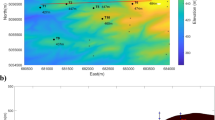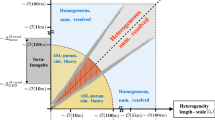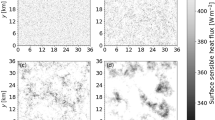Abstract
The impacts of surface heterogeneity and land surface parameterization on the mesoscale processes were studied. Experiments were conducted using the Weather Research and Forecasting (WRF) model coupled with a simple (slab) land surface model (LSM), a relatively complex Noah LSM, and a land data assimilation system (LDAS) with detailed surface fields. Three heterogeneity length scales: 1, 3, and 9 km, were employed to alter land cover and land use. A series of simulations were performed over the U.S. Southern Great Plains during the summer when the soil moisture was abundant. Results indicate that both the land surface parameterizations and fine-scale surface heterogeneity affect the model simulations; and the impact of land surface parameterization is found to be more important, particularly for low frequency (\(f<{10}^{-4} \mathrm{hz}\)) eddies and mesoscale circulations. Substantial variations in turbulent spectra were also noted, and the energy spectra respond nonlinearly to the changes in the heterogeneous length scales. Three important conclusions emerge: (i) more detailed land surface representation reduces uncertainty in simulations of surface fluxes via improved turbulence characterization over a heterogeneous land surface, which helps improve simulations of land–atmosphere feedbacks; (ii) the impact of land surface heterogeneity on atmospheric feedbacks can be detected in the mesoscale circulations that are roughly four times of the spatial heterogeneity scale; and (iii) the land surface heterogeneity that can influence mesoscale circulations would be a function of grid spacing in the model.













Similar content being viewed by others
References
Alapaty K, Raman S, Niyogi D (1997) Uncertainty in the specification of surface characteristics: a study of prediction errors in the boundary layer. Bound-Lay Meteorol 82:475–502. https://doi.org/10.1023/A:1017166907476
Alfieri JG, Blanken PD (2012) How representative is a point? The spatial variability of surface energy fluxes across short distances in a sand-sagebrush ecosystem. J Arid Environ 48:42–49. https://doi.org/10.1016/j.jaridenv.2012.04.010
Alfieri JG, Niyogi D, Zhang H, LeMone MA, Chen F (2009) Quantifying the spatial variability of surface fluxes using data from the 2002 International H2O Project. Bound-Lay Meteorol 133:323–341. https://doi.org/10.1007/s10546-009-9406-2
Avissar R, Pielke RA (1989) A parameterization of heterogeneous land surfaces for atmospheric numerical models and its impact on regional meteorology. Mon Wea Rev 117:2113–2136. https://doi.org/10.1175/1520-0493(1989)117%3c2113:APOHLS%3e2.0.CO;2
Avissar R, Chen F (1993) Development and analysis of prognostic equations for mesoscale kinetic energy and mesoscale (subgrid scale) fluxes for large-scale atmospheric models. J Atmos Sci 50:3751–3774. https://doi.org/10.1175/1520-0469(1993)050%3c3751:DAAOPE%3e2.0.CO;2
Avissar R, Liu Y (1996) Three-dimensional numerical study of shallow convective clouds and precipitation induced by land surface forcing. J Geophys Res 101(D3):7499–7518. https://doi.org/10.1029/95JD03031
Avissar R, Eloranta EW, Gürer K, Tripoli GJ (1998) An evaluation of the large-eddy simulation option of the regional atmospheric modeling system in simulating a convective boundary layer: a FIFE case study. J Atmos Sci 55:1109–1130
Avissar R, Schmidt T (1998) An evaluation of the scale at which ground-surface heat flux patchiness affects the convective boundary layer using large-eddy simulations. J Atmos Sci 55:2666–2689. https://doi.org/10.1175/1520-0469(1998)055%3c2666:AEOTSA%3e2.0.CO;2
Baidya Roy S, Avissar R (2000) Scales of response of the convective boundary layer to surface heterogeneity. Geophys Res Lett 27:533–536. https://doi.org/10.1029/1999GL010971
Baldi M, Dalu GA, Pielke RA, Meneguzzo F (2005) Analytical evaluation of mesoscale fluxes and pressure field. Environ Fluid Mech 5:3. https://doi.org/10.1007/s10652-005-8089-6
Brunsell NA, Mechem DB, Anderson MC (2011) Surface heterogeneity impacts on boundary layer dynamics via energy balance partitioning. Atmos Chem Phys 11:3403–3416. https://doi.org/10.5194/acp-11-3403-2011
Bukovsky MS, Karoly DJ (2009) Precipitation simulations using WRF as a nested regional climate model. J Appl Meteor Climatol 48:2152–2159. https://doi.org/10.1175/2009JAMC2186.1
Cai X, Yang Z-L, Xia Y, Huang M, Wei H, Leung LR, Ek MB (2014) Assessment of simulated water balance from Noah, Noah-MP, CLM, and VIC over CONUS using the NLDAS test bed. J Geophys Res Atmos 119(24):13751–13770. https://doi.org/10.1002/2014JD022113
Case JL, Kumar SV, Srikishen J, Jedlovec GJ (2011) Improving numerical weather predictions of summertime precipitation over the southeastern United States through a high-resolution initialization of the surface state. Wea Forecasting 26:785–807. https://doi.org/10.1175/2011WAF2222455.1
Charusombat U, Niyogi D, Garrigues S et al (2012) Noah-GEM and land data assimilation system (LDAS) based downscaling of global reanalysis surface fields: evaluations using observations from a CarboEurope agricultural site. Comput Electron Agric 86:55–74. https://doi.org/10.1016/j.compag.2011.12.001
Chen F, Avissar R (1994) Impact of land surface moisture variability on local shallow convective cumulus and precipitation in large-scale models. J Appl Meteor 33:1382–1401. https://doi.org/10.1175/1520-0450(1994)033%3c1382:IOLSMV%3e2.0.CO;2
Chen F, Dudhia J (2001) Coupling an advanced land surface–hydrology model with the Penn State-NCAR MM5 modeling system. Part I: model implementation and sensitivity. Mon Wea Rev 129:569–585. https://doi.org/10.1175/1520-0493(2001)129%3c0569:CAALSH%3e2.0.CO;2
Chen F, Manning KW, LeMone MA et al (2007) Description and evaluation of the characteristics of the NCAR high-resolution land data assimilation system. J Appl Meteor Climatol 46:694–713. https://doi.org/10.1175/JAM2463.1
Cheng Y, Canuto VM, Howard AM (2002) An improved model for the turbulent PBL. J Atmos Sci 59:1550–1565
Ching J, Rotunno R, LeMone M, Martilli A, Kosovic B, Jimenez PA, Dudhia J (2014) Convectively induced secondary circulations in fine-grid mesoscale numerical weather prediction models. Mon Wea Rev 142:3284–3302. https://doi.org/10.1175/MWR-D-13-00318.1
De Meij A, Zittis G, Christoudias T (2019) On the uncertainties introduced by land cover data in high-resolution regional simulations. Meteorol Atmos Phy 131(5):1213–1223
de Vrese P, Schulz J-P, Hagemann S (2016) On the representation of heterogeneity in land-surface-atmosphere coupling. Bound Layer Meteor 160:157–183. https://doi.org/10.1007/s10546-016-0133-1
Deardorff JW (1978) Efficient prediction of ground surface temperature and moisture, with inclusion of a layer of vegetation. J Geophys Res 83:1889–1903. https://doi.org/10.1029/JC083iC04p01889
Deardorff JW, Willis GE (1982) Investigation of the frozen-turbulence hypothesis for temperature spectra in a convectively mixed layer. Phy Fluids 25:21–28
Deng A, Stauffer DR (2006) On improving 4-km mesoscale model simulations. J Appl Meteorol Clim 45:361–381
Dirmeyer PA, Gao X, Zhao M, Guo Z, Oki T, Naota H (2006) GSWP-2: multimodel analysis and implications for our perception of the land surface. Bull Amer Meteor Soc 87:1381–1397. https://doi.org/10.1175/BAMS-87-10-1381
Dudhia J (1989) Numerical study of convection observed during the winter monsoon experiment using a mesoscale two-dimensional model. J Atmos Sci 46:3077–3107
Eastman JL, Pielke RA, McDonald DJ (1998) Calibration of soil moisture for large eddy simulations over the FIFE area. J Atmos Sci 55:1131–1140
Eltahir EAB (1998) A soil moisture-rainfall feedback mechanism: 1 Theory and observations. Water Resour Res 34(4):765–776. https://doi.org/10.1029/97WR03499
Findell KL, Gentine P, Lintner BR, Kerr C (2011) Probability of afternoon precipitation in eastern United States and Mexico enhanced by high evaporation. Nat Geosci 4:434–439. https://doi.org/10.1038/ngeo1174
Hadfield MG, Cotton WR, Pielke RA (1992) Large-eddy simulations of thermally forced circulations in the convective boundary layer. Part II: the effect of changes in wavelength and wind speed. Bound.-Layer Meteor. 58:307–328.
Harder P, Pomeroy JW, Helgason W (2017) Local scale advection of sensible and latent heat during snowmelt. Geophys Res Lett 44:9769–9777. https://doi.org/10.1002/2017GL074394
He J, Yu Y, Yu LJ, Na L (2017) Impacts of uncertainty in land surface information on simulated surface temperature and precipitation over China. Int J Climatol 37:829–847
Henderson-Sellers A, Pitman AJ, Love PK, Irannejad P, Chen TH (1995) The project for intercomparison of land surface parameterization schemes (PILPS): Phases 2 and 3. Bull Amer Meteor Soc 76:489–503. https://doi.org/10.1175/1520-0477(1995)076%3c0489:TPFIOL%3e2.0.CO;2
Henderson-Sellers A, McGuffie K, Pitman AJ (1996) The project for intercomparison of land surface parametrization schemes (PILPS): 1992 to 1995. Clim Dyn 12(12):849–859. https://doi.org/10.1007/s003820050147
Holt TR, Niyogi D, Chen F, Manning K, LeMone MA (2006) Effect of land-atmosphere interactions on the IHOP 24–25 May 2002 convection case. Mon Wea Rev 134:113–133. https://doi.org/10.1175/MWR3057.1
Hong SY, Pan HL (1996) Nonlocal boundary layer vertical diffusion in a medium-range forecast model. Mon Wea Rev 124:2322–2339. https://doi.org/10.1175/1520-0493(1996)124%3c2322:NBLVDI%3e2.0.CO;2
Huang HY, Margulis SA (2009) On the impact of surface heterogeneity on a realistic convective boundary layer. Water Resour Res 45:W04425. https://doi.org/10.1029/2008WR007175
Janjic ZI (1994) The step-mountain eta coordinate model: further developments of the convection, viscous sublayer, and turbulence closure schemes. Mon Weather Rev 122(5):927–945. https://doi.org/10.1175/1520-0493(1994)122%3c0927:TSMECM%3e2.0.CO;2
Janjic ZI (2000) Comments on “Development and evaluation of a convection scheme for use in climate models.” J Atmos Sci 57(21):3686. https://doi.org/10.1175/1520-0469(2000)057%3c3686:CODAEO%3e2.0.CO;2
Janjic Z I (2001) Nonsingular implementation of the Mellor-Yamada level 2.5 scheme in the NCEP Meso Model. Office Note No. 437, National Centers for Environmental Prediction, 61 pp.
Jeworrek J, West G, Stull R (2019) Evaluation of cumulus and microphysics parameterizations in WRF across the convective gray zone. Wea Forecasting 34:1097–1115
Kang SL, Davis KJ, LeMone MA (2007) Observations of the ABL structures over a heterogeneous land surface during IHOP_2002. J Hydrometeorol 8:221–244. https://doi.org/10.1175/JHM567.1
Koster RD, Suarez MJ, Higgins RW, Van den Dool HM (2003) Observational evidence that soil moisture variations affect precipitation. Geophys Res Lett 30:1241. https://doi.org/10.1029/2002GL016571
Koster RD et al (2004) Regions of strong coupling between soil moisture and precipitation. Science 305:1138–1140. https://doi.org/10.1126/science.1100217
LeMone MA, Chen F, Alfieri JG, Tewari M, Geerts B, Miao Q, Grossman RL, Coulter RL (2007) Influence of land cover and soil moisture on the horizontal distribution of sensible and latent heat fluxes in southeast Kansas during IHOP_2002 and CASES-97. J Hydrometeorol 8:68–87. https://doi.org/10.1175/JHM554.1
LeMone MA, Tewari M, Chen F, Alfieri JG, Niyogi D (2008) Evaluation of the Noah land surface model using data from a fair-weather IHOP_2002 day with heterogeneous surface fluxes. Mon Weather Rev 136:4915–4941. https://doi.org/10.1175/2008MWR2354.1
LeMone MA, Tewari M, Chen F, Dudhia J (2013) Objectively determined fair-weather CBL depths in the ARW-WRF model and their comparison to CASES-97 observations. Mon Wea Rev 141:30–54. https://doi.org/10.1175/MWR-D-12-00106.1
LeMone MA, Tewari M, Chen F, Dudhia J (2014) Objectively determined fair-weather NBL features in ARW-WRF and their comparison to CASES-97 observations. Mon Wea Rev 142:2709–2732. https://doi.org/10.1175/MWR-D-13-00358.1
Letcher TW, Minder JR (2017) The simulated response of diurnal mountain winds to regionally enhanced warming caused by the snow albedo feedback. J Atmos Sci 74:49–67. https://doi.org/10.1175/JAS-D-16-0158.1
Liston GE (2004) Representing subgrid snow cover heterogeneities in regional and global models. Climate J 17:1381–1397. https://doi.org/10.1175/1520-0442(2004)017%3c1381:RSSCHI%3e2.0.CO;2
Ménard CB, Essery R, Pomeroy J (2014) Modelled sensitivity of the snow regime to topography, shrub fraction and shrub height. Hydrol Earth Syst Sci 18:2375–2392. https://doi.org/10.5194/hess-18-2375-2014
Mlawer EJ, Taubman SJ, Brown PD, Iacono MJ, Cough SA (1997) Radiative transfer for inhomogeneous atmosphere: RRTM, a validated correlated-k model for the longwave. J Geophys Res 102(D14):16663–16682. https://doi.org/10.1029/97JD00237
Mott R, Schlögl S, Dirks L, Lehning M (2017) Impact of extreme land surface heterogeneity on micrometeorology over spring snow cover. J Hydrometeor 18:2705–2722. https://doi.org/10.1175/JHM-D-17-0074.1
Mott R, Vionnet V, Grünewald T (2018) The seasonal snow cover dynamics: review on wind-driven coupling processes. Front Earth Sci 6:197. https://doi.org/10.3389/feart.2018.00197
Niyogi D (2019) Land surface processes. In: Current trends in the representation of physical processes in weather and climate models (pp 349–370). Springer, Singapore.
Niyogi D, Raman S, Alapaty K (1999) Uncertainty in specification of surface characteristics, Part II: hierarchy of interaction explicit statistical analysis. Bound-Lay Meteorol 91:341–366. https://doi.org/10.1023/A:1002023724201
Niyogi D, Holt T, Zhong S, Pyle PC, Basara J (2006) Urban and land surface effects on the 30 July 2003 mesoscale convective system event observed in the Southern Great Plains. J Geophys Res 111:D19107. https://doi.org/10.1029/2005JD006746
Niyogi D, Mahmood R, Adegoke JO (2009) Land-use/land-cover change and its impacts on weather and climate. Bound-Lay Meteorol 133:297–298. https://doi.org/10.1007/s10546-009-9437-8
Niyogi D, Alapaty K, Raman S, Chen F (2009) Development and evaluation of a coupled photosynthesis-based gas exchange evapotranspiration model (GEM) for mesoscale weather forecasting applications. J Appl Meteorol Climatol 48:349–368. https://doi.org/10.1175/2008JAMC1662.1
Niu GY et al (2011) The community Noah land surface model with multiparameterization options (Noah-MP): 1. Model description and evaluation with local-scale measurements. J. Geophys. Res., 116: D12109, doi: 10.1029/2010JD015139.
Pielke RA, Kallos G, Segal M (1989) Horizontal resolution needs for adequate lower tropospheric profiling involved with atmospheric systems forced by horizontal gradients in surface heating. J Atmos Oceanic Technol 6:741–758. https://doi.org/10.1175/1520-0426(1989)006%3c0741:HRNFAL%3e2.0.CO;2
Pielke RA, Uliasz M (1993) Influence of landscape variability on atmospheric dispersion. J Air Waste Mgt 43:989–994
Pielke RA Sr, Pitman A, Niyogi D, Mahmood R, McAlpine C, Hossain F, Goldewijk KK, Nair U, Betts R, Fall S, Reichstein M (2011) Land use/land cover changes and climate: modeling analysis and observational evidence. Wiley Interdisciplinary Reviews: Climate Change 2(6):828–850
Prasad SK, Mohanty UC, Routray A, Osuri KK, Ramakrishna S, Niyogi D (2014) Impact of Doppler weather radar data on thunderstorm simulation during STORM pilot phase—2009. Nat Hazards 74:1403–1427
Reen BP, Stauffer DR, Davis KJ (2014) Land surface heterogeneity effects in the planetary boundary layer. Bound-Lay Meteorol 150(1):1–31. https://doi.org/10.1007/s10546-013-9860-8
Santanello JA Jr, Peters-Lidard CD, Kennedy A, Kumar SV (2013) Diagnosing the nature of land-atmosphere coupling: A case study of dry/wet extremes in the U.S Southern Great Plains. J Hydrometeor 14:3–24. https://doi.org/10.1175/JHM-D-12-023.1
Schmid HP (2002) Footprint modeling for vegetation atmosphere exchange studies: a review and perspective. Agr Forest Meteorol 113:159–183. https://doi.org/10.1016/S0168-1923(02)00107-7
Skamarock WC (2004) Evaluating mesoscale NWP models using kinetic energy spectra. Mon Weather Rev 132(12):3019–3032. https://doi.org/10.1175/MWR2830.1
Skamarock W C, Dempsey D (2005) High resolution winter season NWP: preliminary evaluation of the WRF-ARW and WRF-NMM models in the DWFE forecast experiment. Preprints. In: 17th Conf. on Numerical Weather Prediction, Washington, DC, Amer. Meteor. Soc., 16A.3.
Skamarock WC, Klemp JB, Dudhia J, Gill DO, Barker DM, Duda MG, Huang XY, Wang W, Powers JG (2008) A description of the Advanced Research WRF version 3. (No. NCAR/TN-475+STR).
Skamarock WC, Park SH, Klemp JB, Snyder C (2014) Atmospheric kinetic energy spectra from global high-resolution nonhydrostatic simulations. J Atmos Sci 71(11):4369–4381
Stokes GM, Schwartz SE (1994) The atmospheric radiation measurement (ARM) program: programmatic background and design of the cloud and radiation test bed. Bull Amer Meteor Soc 75:1201–1221. https://doi.org/10.1175/1520-0477(1994)075%3c1201:TARMPP%3e2.0.CO;2
Stull R B (1988) An introduction to boundary layer meteorology, Springer Science & Business Media, 1–671.
Tian Y, Miao J (2019) A numerical study of mountain-plain breeze circulation in Eastern Chengdu China. Sustainability 11(10):2821
Trapp RJ, Robinson ED, Baldwin ME, Diffenbaugh NS, Schwedler BR (2011) Regional climate of hazardous convective weather through high-resolution dynamical downscaling. Clim Dyn 37(3–4):677–688
Trier SB, Chen F, Manning KW (2004) A study of convection initiation in a mesoscale model using high-resolution land surface initial conditions. Mon Weather Rev 132:2954–2976. https://doi.org/10.1175/MWR2839.1
Trier SB, Chen F, Manning KW, LeMone MA, Davis CA (2008) Sensitivity of the PBL and precipitation in 12-Day simulations of warm-season convection using different land surface models and soil wetness conditions. Mon Wea Rev 136:2321–2343. https://doi.org/10.1175/2007MWR2289.1
Wang D, Miao J, Zhang D (2015) Numerical simulations of local circulation and its response to land cover changes over the Yellow Mountains of China. J Meteorol Res 29:667–681
Wang J, Bras RL, Eltahir EAB (1996) A stochastic linear theory of mesoscale circulation induced by the thermal heterogeneity of the land surface. J Atmos Sci 53:3349–3366. https://doi.org/10.1175/1520-0469(1996)053%3c3349:ASLTOM%3e2.0.CO;2
Weaver CP (2004a) Coupling between large-scale atmospheric processes and mesoscale land-atmosphere interactions in the U.S. Southern great plains during summer Part I: case studies. J Hydrometeorol 5:1223–1246. https://doi.org/10.1175/JHM-396.1
Weaver CP (2004b) Coupling between large-scale atmospheric processes and mesoscale land-atmosphere interactions in the U.S. Southern Great Plains during summer. Part II: mean Impacts of the Mesoscale. J Hydrometeorol 5:1247–1258. https://doi.org/10.1175/JHM-397.1
Weaver C P, Baidya Roy S, Avissar R (2002) Sensitivity of simulated mesoscale atmospheric circulations resulting from landscape heterogeneity to aspects of model configuration. J Geophys Res 107(0), doi: 10.1029/2001JD000376.
Wei HL, Xia YL, Mitchell KE, Ek MB (2013) Improvement of the Noah land surface model for warm season processes: evaluation of water and energy flux simulation. Hydrol Processes 27(2):297–303
Yates DN, Chen F, Nagai H (2003) Land surface heterogeneity in the cooperative atmosphere surface exchange study (CASES-97). Part II: analysis of spatial heterogeneity and its scaling. J Hydrometeorol 4:219–234. https://doi.org/10.1175/1525-7541(2003)4%3C219:LSHITC%3E2.0.CO;2
Zhang N, Williams QL, Liu H (2010) Effects of land surface heterogeneity on numerical simulations of mesoscale atmospheric boundary layer processes. Theor Appl Climatol 102:307–317. https://doi.org/10.1007/s00704-010-0268-9
Zheng Y, Kumar A, Niyogi D (2015) Impacts of land-atmosphere coupling on regional rainfall and convection. Clim Dyn 44:2383–2409. https://doi.org/10.1007/s00382-014-2442-8
Zheng Y, Alapaty K, Herwehe JA, Del Genio AD, Niyogi D (2016) Improving high-resolution weather forecasts using the weather research and forecasting (WRF) Model with an updated Kain-Fritsch scheme. Mon Wea Rev 144:833–860. https://doi.org/10.1175/MWR-D-15-0005.1
Zhong S, Doran JC (1995) A modeling study of the effects of inhomogeneous surface fluxes on boundary-layer properties. J Atmos Sci 52:3129–3142. https://doi.org/10.1175/1520-0469(1995)052%3c3129:AMSOTE%3e2.0.CO;2
Zhou B, Simon JS, Chow FK (2014) The convective boundary layer in the Terra Incognita. J Atmos Sci 71:2545–2563. https://doi.org/10.1175/JAS-D-13-0356.1
Acknowledgements
This study benefitted in part through USDA National Institute of Food and Agriculture (NIFA) Hatch project 1007699, and the National Institute of Food and Agriculture (NIFA) Drought Trigger projects through Texas A&M at Purdue (2011-67019-20042), as well as the Department of Energy’s Atmospheric Radiation Measurement Program (DOE-ARM), the National Science Foundation (NSF) Hydrology Community-based Data Interoperability Networks (INTEROP). Additional support for the KON Ameriflux site was provided through a subcontract to the NSF Long Term Ecological Research Program at the Konza Prairie Biological Station (DEB-0823341; subcontract: SS1093) and subcontract number 7114774 from the Lawrence Berkeley National Laboratory under DOE contract DE-AC02-05CH11231. This study was part of the Ph.D. dissertation by YZ with DN as the graduate adviser. The authors also thank Dr. Jun Feng Miao from Nanjing University of Information Science and Technology for his comments that helped improved the paper.
Author information
Authors and Affiliations
Corresponding author
Additional information
Responsible Editor: Junfeng Miao.
Publisher's Note
Springer Nature remains neutral with regard to jurisdictional claims in published maps and institutional affiliations.
Rights and permissions
About this article
Cite this article
Zheng, Y., Brunsell, N.A., Alfieri, J.G. et al. Impacts of land cover heterogeneity and land surface parameterizations on turbulent characteristics and mesoscale simulations. Meteorol Atmos Phys 133, 589–610 (2021). https://doi.org/10.1007/s00703-020-00768-9
Received:
Accepted:
Published:
Issue Date:
DOI: https://doi.org/10.1007/s00703-020-00768-9




